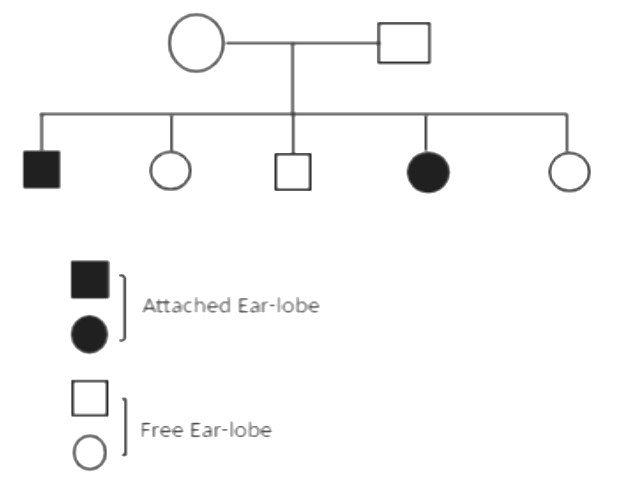
Given below is a pedigree chart of a family with five children. It shows the inheritance of attached ear-lobes as opposed to the free ones. The squares represent the male individuals and circles represent the female individuals. Which one of the following conclusions drawn is correct?

a. Parents are homozygous dominant
b. Parents are heterozygous
c. Parents are homozygous recessive
d. Trait is Y- linked

Answer
489.3k+ views
Hint: From the above pedigree chart it is visible that both parents are not affected with the attached ear lobe therefore the trait is a recessive condition in parents. They served as a carrier of a trait as the next progeny gets affected. if the trait was dominant it would have been visible in one of the parents.
Complete answer:
> Considering the trait for dominant free ear lobe as E and the recessive attached are lobe as e. In the generation of parents, it is visible that none of them are affected. So based on this it is confirmed that the trait is recessive
> The parents are in heterozygous condition (Ee) with the carrier of the trait. In the next generation, one male one female progeny shows the defect as the recessive trait gets expressed. This is because the affected progeny are in the homozygous condition (ee).
> Thus from the above explanation, it is clear that the trait is recessive and it is not shown in the parents as both mother and father are heterozygous. It is a case of an autosomal inheritance trait.
Hence, the correct answer is option (B).
Note: The chart given above is called the pedigree chart. The pedigree is the diagram to show the ancestral relationship and transmission of characters over several generations in the human family.
Here the genes for attached ear lobes are located on autosomes in both the sexes and it is not expressed in heterozygous condition as allele E is dominant over allele.
Complete answer:
> Considering the trait for dominant free ear lobe as E and the recessive attached are lobe as e. In the generation of parents, it is visible that none of them are affected. So based on this it is confirmed that the trait is recessive
> The parents are in heterozygous condition (Ee) with the carrier of the trait. In the next generation, one male one female progeny shows the defect as the recessive trait gets expressed. This is because the affected progeny are in the homozygous condition (ee).
> Thus from the above explanation, it is clear that the trait is recessive and it is not shown in the parents as both mother and father are heterozygous. It is a case of an autosomal inheritance trait.
Hence, the correct answer is option (B).
Note: The chart given above is called the pedigree chart. The pedigree is the diagram to show the ancestral relationship and transmission of characters over several generations in the human family.
Here the genes for attached ear lobes are located on autosomes in both the sexes and it is not expressed in heterozygous condition as allele E is dominant over allele.
Recently Updated Pages
Master Class 12 Business Studies: Engaging Questions & Answers for Success

Master Class 12 English: Engaging Questions & Answers for Success

Master Class 12 Social Science: Engaging Questions & Answers for Success

Master Class 12 Chemistry: Engaging Questions & Answers for Success

Class 12 Question and Answer - Your Ultimate Solutions Guide

Master Class 11 Business Studies: Engaging Questions & Answers for Success

Trending doubts
Draw a labelled sketch of the human eye class 12 physics CBSE

a Tabulate the differences in the characteristics of class 12 chemistry CBSE

Which one of the following is a true fish A Jellyfish class 12 biology CBSE

Why is the cell called the structural and functional class 12 biology CBSE

Differentiate between homogeneous and heterogeneous class 12 chemistry CBSE

Write the difference between solid liquid and gas class 12 chemistry CBSE




